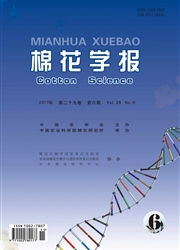

 中文摘要:
中文摘要:
对2008年来自江苏的37个棉花黄萎病菌菌株进行了培养特性及致病性分化监测。根据在PDA培养基上生长时形成徽菌核的多少,菌株可分为3种培养类型,其中菌核型占54.1%,菌丝型占24.3%,中间型占21.6%。菌核型上升成为主要的培养类型,并且出现了初分离培养时,菌落特征为完全黑色微菌核的菌膜菌核型菌株。采用特异性引物(D-1/D-2和ND-1/ND.2)PCR检测菌株的致病类型,结果落叶型菌株占83.8%,非落叶型菌株占16.2%,显示目前江苏省棉花黄萎病菌以落叶型菌株为主,并且在每个植棉市都有分布。苗期致病力测定表明江苏省棉花黄萎病菌存在明显的致病力分化,其中致病力强的菌株占27.0%,中等的占40.5%,弱的占32.4%,并且在落叶型和非落叶型群体中都存在致病力强、中、弱的菌株。
 英文摘要:
英文摘要:
To evaluate the cultural characteristics and pathogenicity differentiation of Verticillium dahliae, 37 strains of the pathogen were isolated from diseased cotton in Jiangsu Province in 2008. According to the quantity of microsclerotia of the colonial morphology on PDA, the strains were divided into three cultural types; The sclerotium type, the hyphal type and the in- termediate type accounted for 54.1%, 24.3% and 21.6% of the total, respectively. The sclerotium type rose to the main type and the velum sclerotium type came forth. The results of special PCR primer(D-I/D-2 and ND-1/ND-2) assay showed that the defoli- ating and nondefoliating strains accounted for 83.8% and 16.2% of the total, respectively. The defoliating pathotype of V. dahli- ae was dominant in Jiangsu cotton region, and distributed in every main cotton production cities of Jiangsu Province at present. In addition, the determination of pathogenicity in the cotton seedling stage also showed that the pathogenicity varied among the strains isolated from Jiangsu. Strong, moderate and weak pathogenicity strains accounted for 27.0%, 40.5% and 32.4% of total strains and existed among the defoliating and nondefoliaing strain groups.
 同期刊论文项目
同期刊论文项目
 同项目期刊论文
同项目期刊论文
 期刊信息
期刊信息
